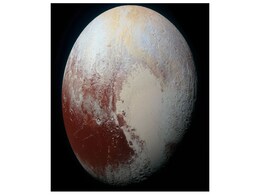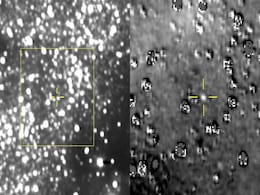Kuiper Belt Object
- All
- News
-

Discovery of Hidden Ninth Planet in Solar System Could Reshape Astronomy, Claims New Study
- Wednesday November 6, 2024
- Written by Gadgets 360 Staff
Scientists are exploring the possibility of a hidden ninth planet in our solar system. The planet, dubbed Planet Nine, is believed to exist beyond Neptune in the Kuiper Belt. Researchers have noticed unusual gravitational effects on distant objects in this region, which may be influenced by the presence of a large, unseen planet. While it has not b...
-
 www.gadgets360.com
www.gadgets360.com
-

New Group of Distant Objects Suggests Our Solar System May Have a Second Kuiper Belt
- Saturday September 21, 2024
- Written by Gadgets 360 Staff
Astronomers have discovered 11 objects beyond the Kuiper Belt, suggesting the existence of a second belt, dubbed "Kuiper Belt 2." Located between 70 and 90 AU from the sun, this new region could redefine our understanding of the solar system's size and structure. The discovery was made using the Subaru telescope in collaboration with NASA’s New H...
-
 www.gadgets360.com
www.gadgets360.com
-

Arrokoth, A Distant Red Object In Kuiper Belt, Is Rich In Sugars: Study
- Monday June 10, 2024
- Science | Edited by Ritu Singh
Researchers found that Arrokoth has a distinctive reddish colour, which is linked to the presence of complex organic molecules.
-
 www.ndtv.com
www.ndtv.com
-

Meet Arrokoth, The Most Distant Space Object Ever Seen Up Close
- Thursday November 14, 2019
- Science | Sarah Kaplan, The Washington Post
The bundle of ice and rock was discovered using a telescope operated in Maryland. It was studied up close by a spacecraft built in the same state. So when NASA scientists had to choose an official name for the most distant object they had ever explored, they borrowed a word from the original inhabitants of this region: Arrokoth, the Powhatan/Algonq...
-
 www.ndtv.com
www.ndtv.com
-

Most Distant Space Object Looks Like Man In Meditation
- Sunday May 19, 2019
- Science | Indo-Asian News Service
NASAs New Horizons mission team has published the first image of the farthest world ever explored -- a planetary building block and Kuiper Belt object clicked during New Years 2019 flyby of Ultima Thule which looks like a human being in deep meditation.
-
 www.ndtv.com
www.ndtv.com
-

This Spacecraft Is En Route To Furthest Object Humans Have Ever Explored
- Tuesday January 1, 2019
- Science | Sarah Kaplan, The Washington Post
The nerdiest New Year's party in the solar system is happening 4 billion miles from Earth, where a lone, intrepid explorer is en route to the furthest object humans have ever explored.
-
 www.ndtv.com
www.ndtv.com
-

NASA Space Probe Detects An 'Icy' Anomaly. Billion Kilometres Past Pluto
- Monday December 24, 2018
- Science | Indo-Asian News Service
Just days ahead of its New Year's 2019 close encounter, NASA's New Horizons spacecraft has detected an anomaly related to its next flyby target -- an icy world a billion kilometres past Pluto and more than 6.5 billion km from Earth.
-
 www.ndtv.com
www.ndtv.com
-

NASA's New Horizons Spots Kuiper Belt Object as Next Flyby Target From Over 160 Million Kilometres Away
- Thursday August 30, 2018
- Indo-Asian News Service
The New Horizons probe is set to encounter the Kuiper Belt object - nicknamed Ultima Thule - on New Year's Eve and New Year's Day, 2019.
-
 www.gadgets360.com
www.gadgets360.com
-

NASA Invites Public To Name Its Next Flyby Target
- Tuesday November 7, 2017
- World News | Press Trust of India
NASA has invited the public to suggest a nickname for the New Horizons mission's next flyby destination - a small, frozen world in the outer edge of our solar system.
-
 www.ndtv.com
www.ndtv.com
-

A New Planet Is Found, Or At Least We Hope So
- Monday July 3, 2017
- World News | Stephen L. Carter, Bloomberg
It turns out that Planet Nine is not the only massive object out there warping the orbits of the KBOs. According to soon-to-be-published research by Kat Volk and Renu Malhotra of the University of Arizona, there's another one.
-
 www.ndtv.com
www.ndtv.com
-

NASA's New Horizons Spacecraft Set to Meet Next Flyby Target - a Kuiper Belt Object
- Tuesday April 4, 2017
- Indo-Asian News Service
It is heading towards its next target - 2014 MU69 - which is a Kuiper Belt object (KBO) and the probe will fly past it on January 1, 2019.
-
 www.gadgets360.com
www.gadgets360.com
-

Pluto Gets A Buddy: A New Dwarf Planet Is Discovered In Our Solar System
- Wednesday October 12, 2016
- World News | Sarah Kaplan, The Washington Post
Out beyond Neptune, past Pluto, through the chaos of the Kuiper belt to a point some 8.5 billion miles from the sun, a new dwarf planet has just joined our solar system.
-
 www.ndtv.com
www.ndtv.com
-

Nasa's New Horizons Spots Kuiper Belt Object
- Wednesday May 18, 2016
- Written by shubhamv
Taken from the spacecraft's Long Range Reconnaissance Imager, the images shatter New Horizons' own record for the closest-ever views of this KBO in November 2015.
-
 www.gadgets360.com
www.gadgets360.com
-

Scientists Dive Into Precious Pluto Data
- Tuesday November 10, 2015
- World News | Indo-Asian News Service
From possible ice volcanoes to twirling moons, NASA's New Horizons science team is busy analysing more than 50 exciting discoveries about Pluto that the probe has revealed so far.
-
 www.ndtv.com
www.ndtv.com
-

Discovery of Hidden Ninth Planet in Solar System Could Reshape Astronomy, Claims New Study
- Wednesday November 6, 2024
- Written by Gadgets 360 Staff
Scientists are exploring the possibility of a hidden ninth planet in our solar system. The planet, dubbed Planet Nine, is believed to exist beyond Neptune in the Kuiper Belt. Researchers have noticed unusual gravitational effects on distant objects in this region, which may be influenced by the presence of a large, unseen planet. While it has not b...
-
 www.gadgets360.com
www.gadgets360.com
-

New Group of Distant Objects Suggests Our Solar System May Have a Second Kuiper Belt
- Saturday September 21, 2024
- Written by Gadgets 360 Staff
Astronomers have discovered 11 objects beyond the Kuiper Belt, suggesting the existence of a second belt, dubbed "Kuiper Belt 2." Located between 70 and 90 AU from the sun, this new region could redefine our understanding of the solar system's size and structure. The discovery was made using the Subaru telescope in collaboration with NASA’s New H...
-
 www.gadgets360.com
www.gadgets360.com
-

Arrokoth, A Distant Red Object In Kuiper Belt, Is Rich In Sugars: Study
- Monday June 10, 2024
- Science | Edited by Ritu Singh
Researchers found that Arrokoth has a distinctive reddish colour, which is linked to the presence of complex organic molecules.
-
 www.ndtv.com
www.ndtv.com
-

Meet Arrokoth, The Most Distant Space Object Ever Seen Up Close
- Thursday November 14, 2019
- Science | Sarah Kaplan, The Washington Post
The bundle of ice and rock was discovered using a telescope operated in Maryland. It was studied up close by a spacecraft built in the same state. So when NASA scientists had to choose an official name for the most distant object they had ever explored, they borrowed a word from the original inhabitants of this region: Arrokoth, the Powhatan/Algonq...
-
 www.ndtv.com
www.ndtv.com
-

Most Distant Space Object Looks Like Man In Meditation
- Sunday May 19, 2019
- Science | Indo-Asian News Service
NASAs New Horizons mission team has published the first image of the farthest world ever explored -- a planetary building block and Kuiper Belt object clicked during New Years 2019 flyby of Ultima Thule which looks like a human being in deep meditation.
-
 www.ndtv.com
www.ndtv.com
-

This Spacecraft Is En Route To Furthest Object Humans Have Ever Explored
- Tuesday January 1, 2019
- Science | Sarah Kaplan, The Washington Post
The nerdiest New Year's party in the solar system is happening 4 billion miles from Earth, where a lone, intrepid explorer is en route to the furthest object humans have ever explored.
-
 www.ndtv.com
www.ndtv.com
-

NASA Space Probe Detects An 'Icy' Anomaly. Billion Kilometres Past Pluto
- Monday December 24, 2018
- Science | Indo-Asian News Service
Just days ahead of its New Year's 2019 close encounter, NASA's New Horizons spacecraft has detected an anomaly related to its next flyby target -- an icy world a billion kilometres past Pluto and more than 6.5 billion km from Earth.
-
 www.ndtv.com
www.ndtv.com
-

NASA's New Horizons Spots Kuiper Belt Object as Next Flyby Target From Over 160 Million Kilometres Away
- Thursday August 30, 2018
- Indo-Asian News Service
The New Horizons probe is set to encounter the Kuiper Belt object - nicknamed Ultima Thule - on New Year's Eve and New Year's Day, 2019.
-
 www.gadgets360.com
www.gadgets360.com
-

NASA Invites Public To Name Its Next Flyby Target
- Tuesday November 7, 2017
- World News | Press Trust of India
NASA has invited the public to suggest a nickname for the New Horizons mission's next flyby destination - a small, frozen world in the outer edge of our solar system.
-
 www.ndtv.com
www.ndtv.com
-

A New Planet Is Found, Or At Least We Hope So
- Monday July 3, 2017
- World News | Stephen L. Carter, Bloomberg
It turns out that Planet Nine is not the only massive object out there warping the orbits of the KBOs. According to soon-to-be-published research by Kat Volk and Renu Malhotra of the University of Arizona, there's another one.
-
 www.ndtv.com
www.ndtv.com
-

NASA's New Horizons Spacecraft Set to Meet Next Flyby Target - a Kuiper Belt Object
- Tuesday April 4, 2017
- Indo-Asian News Service
It is heading towards its next target - 2014 MU69 - which is a Kuiper Belt object (KBO) and the probe will fly past it on January 1, 2019.
-
 www.gadgets360.com
www.gadgets360.com
-

Pluto Gets A Buddy: A New Dwarf Planet Is Discovered In Our Solar System
- Wednesday October 12, 2016
- World News | Sarah Kaplan, The Washington Post
Out beyond Neptune, past Pluto, through the chaos of the Kuiper belt to a point some 8.5 billion miles from the sun, a new dwarf planet has just joined our solar system.
-
 www.ndtv.com
www.ndtv.com
-

Nasa's New Horizons Spots Kuiper Belt Object
- Wednesday May 18, 2016
- Written by shubhamv
Taken from the spacecraft's Long Range Reconnaissance Imager, the images shatter New Horizons' own record for the closest-ever views of this KBO in November 2015.
-
 www.gadgets360.com
www.gadgets360.com
-

Scientists Dive Into Precious Pluto Data
- Tuesday November 10, 2015
- World News | Indo-Asian News Service
From possible ice volcanoes to twirling moons, NASA's New Horizons science team is busy analysing more than 50 exciting discoveries about Pluto that the probe has revealed so far.
-
 www.ndtv.com
www.ndtv.com
















